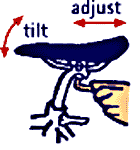|
Mountain biking is a blast and enjoyable at a whole range of different levels. Regretfully the sport is geared more towards men than women. But it's actually very easy to choose and fine tune your bike so it works equally well for you as a woman cyclist.
Selecting the Right Bike
Bikes are sized according to the length (height) of the seat tube, eg. 15", 17", etc. Use the "stand over" method to zero in on the right frame for you: when standing astride the bike there should be 7 to 10cm clearance between your crotch and the top tube (be wary when comparing different brands as they all seem to measure their frames differently).
Equally important is the top tube length. You need to be able to stretch out comfortably when riding. Often women have shorter upper bodies and longer legs than men. If this applies to you then go for a design with a relatively short top tube.
Women tend to be lighter and ride with more finesse than men so can safely use a lighter frame, wheels and componentry. Lightweight bikes cause less puff on those interminable hill climbs and are easier to lift over gates, but you may have to mortgage several limbs to own one.
Front suspension absorbs the big bumps and reduces vibration - increasing comfort and safety to make your ride generally more enjoyable ... strongly recommended if you plan to spend time off road. And of course a lightweight dual suspension bike is the ultimate for "arm chair" comfort.
Swapping Parts
Before you drive your new bike out of the showroom consider a couple of standard modifications that will make it more "woman friendly":
Exchange the saddle for a women's model. There are an increasing number on the market - they tend to be narrower in the front and wider at the back, to better suit a woman's pelvis shape. And some, like the Terry brand, have a hollow nose which is amazingly comfortable.
If the frame is the right height but you have to stretch out a bit far to reach the handle bars then you may want to swap your stem for a shorter one. Deal with a reputable bike shop - they should be able to offer good advice and happily make changes for little or no charge.
Sorting Out Your Bike
Spend some time fine tuning your bike to fit you. Here are some guidelines ...
Seat height - while sitting on your bike with your pelvis square on the saddle put one heel on the pedal at its lowest point. Your leg should be almost straight when your seat is at the correct height.
Seat angle - for women, tilting the nose slightly down from horizontal seems to be the most comfortable. If you find yourself constantly slipping forward then you've over done it!
Seat position - adjust the saddle either backwards or forwards so that when the pedal cranks are horizontal, the back of your knee cap is directly over the ball of your foot.
 Brake lever reach - women's hands are generally smaller than men's but you can adjust most levers in to provide a comfortable reach. Numb hands are a sure sign that either the reach or brake angle is incorrect. Brake lever reach - women's hands are generally smaller than men's but you can adjust most levers in to provide a comfortable reach. Numb hands are a sure sign that either the reach or brake angle is incorrect.
Shocks need to be soft enough for your body weight. With elastomer versions ensure the shop sets them up with the correct bumpers.
If you're under 60kg then you'll be able to get away with running softer tyres than the lads (30-35 psi) without risking snake bite punctures. This contributes to a more comfortable ride and provides better traction.
On the Trail
Don't underestimate the amount of fuel you need to keep going. Take adequate food and snack regularly. Also, you should aim to drink 1 litre of water per hour. The right food and drink can help compensate for any lack of fitness.
Poor circulation resulting in cold fingers and toes is an issue for most women. Always take polypropylene gloves with you, wear decent socks (Lucifers from Ground Effect are good in the winter) and beware of over tight shoes.
Men are generally stronger, faster and a bit more gung ho on the bike. So when you're out with the boys be sure to travel at your own pace. At the start of the ride, gain agreement to stop and re group regularly (at least every 30 minutes).
|